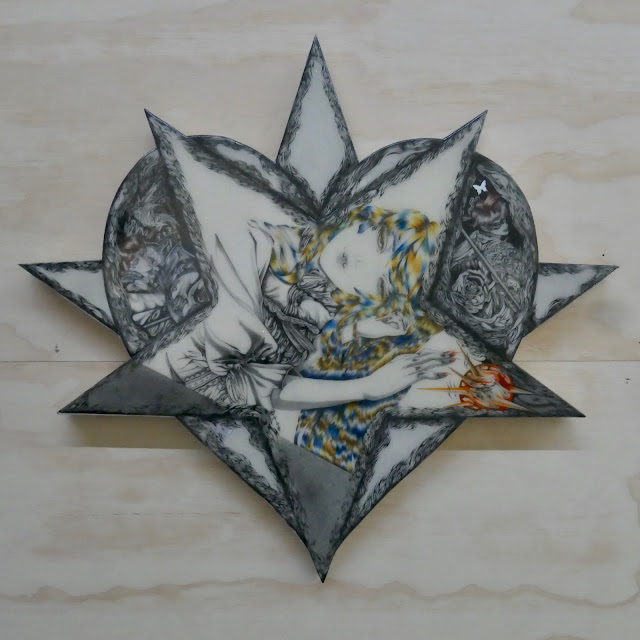The Palais de Tokyo's summer exhibitions, 2023
The Palais de Tokyo has no air-conditioning, and some of its galleries have glass roofs, so in the summer the place can get very hot. I well remember, during Prince.sse.s des Villes, the sprawling summer exhibition of 2019, it was stifling. It has, however, an abundance of labyrinthine, relatively rarely-used underground spaces in bare concrete. The drop from the avenue in front of the Palais to the streets at the back, at river level, is considerable. (The long flights of stairs are familiar to me from visits to the Iranian embassy's visa department.) I've no idea how many buried levels the building actually has. Anyway, this year, the curators have had the clever idea of going down nearly as deep as possible, creating a new pathway starting at least two floors below street level, where it's dark and cool. Exhibition halls on the main and upper floors aren't used at all; only the ticket offices, shop and restaurant are still open. Guards and visitors can all be grateful for it.
Three of this summer's exhibitions - four in all, unless I missed something - at the Palais de Tokyo recalled thoughts I had at the Athens Biennale in 2021, about the impact of unusual exhibition spaces and expert curating on that of the works exhibited. Some of the things on display also recalled my impressions on visiting Theaster Gates' Amalgam in the same museum in 2019.
In Athens, what struck me was how the fascination an unusual space can exert, combined with sophisticated curating, may risk distracting from, even overpowering, the works on show. Today, I certainly remember that Biennale's spaces (a disused department store, an old courthouse and gaol, an abandoned office block) and how they were used better than much of what was inside. In the case of Gates, I felt that the sleek, clean, careful, even 'deluxe' presentation risked undermining the seriousness of his content, sucking out the drama and reducing the works almost to high-end interior design statements.
Lara Lamiel's big exhibition, Vous les entendez?, in a cool basement resembling an underground car park, begins with quite an unsettling, faintly menacing installation of sharp surgical-style instruments and glistening, broken glass (inevitably, you imagine yourself walking across it, barefoot), all carefully, icily lit, and expanded by a wall of mirrors at the rear. (Not far away, a balcony view of a large video screen installed in another room, one floor down, demonstrates that, even at this low level, there's still more Palais beneath. What a building it is.)
However, my feeling, as I advanced through the exhibition, was that, as with Gates, the meticulous positioning of the objects, the careful mise en scène, the colour coordination, clever lighting and reflections... relieved the works of mystery or menace. They were intriguing, curious, sometimes faintly worrying, sometimes witty... but in the end only mildly engaging. We were in a handsome installation of obviously well thought-out work, but somewhere on the borderline (admittedly an interesting one, worthy of investigation) between art and design. Even the way the paintings, which I liked a lot, were displayed turned the cool, concrete rooms into chic places you might like to live in - as if, even in temperate Paris, we might have cool, underground summer apartments, like the palaces in Iran's torrid desert cities.
This 'designer chic' feeling was even stronger one floor up in the installation Morphologies Souterraines, by Mountaincutters - like Vous les entendez?, conceived expressly to interact with the space it was installed in. Here, an artist I love but will not name went so far as to say he could discern no actual content in it at all. Just, again, careful (to the point of being anal-retentive; even the patches of decay looked carefully contrived) displays of a variety of materials and objects, both found and custom-made, with a trendy, vaguely industrial and ultimately fake (e.g. copper piping going nowhere, doing nothing) feel.























Comments
Post a Comment